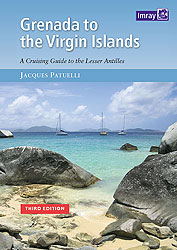| |
|
The natural environment
Geology - Volcanic and Coralline Massifs
With the exception of Barbados in the east, which is coralline, the archipelago rests on a mountainous ridge in the form of an arc almost 900km long. Geologically, the youngest islands are essentially volcanic, with markedly irregular relief which attains considerable height.
Some of the volcanoes are definitively extinct, others are quiescent (semiactive), marked only by fumaroles and sulphury smoke.
However, some re-activate from time to time and the eruptions can cause significant damage and loss of life, for example, Mont Pelée (Martinique) and la Soufrière (St Vincent) in 1902, la Soufrière (Guadeloupe) in 1976, and more recently la Soufrière of Galway, which has destroyed half of Montserrat.

The older islands, the eroded bases of volcanoes, are now partly topped by limestone formations: for example La Grande Terre near Guadeloupe, Antigua, St Martin, Anguilla, etc.
Flora and Fauna
Because the archipelago is so far from the continent of the Americas, a large part of its flora and fauna has resulted from successive mixing between the islands. The result across the island group is therefore quite homogeneous.

Fauna
The Antillean fauna is relatively poor, especially in mammals. During the colonial period intensive hunting was responsible for the extinction of some species. Today the majority are protected.
Birds are more numerous and characterized by vibrant colours: the colibri or humming bird with its lightning swift flight, the parrots, of which the Sisserou has become Dominica’s emblem, the black Great Frigate Birds with the male’s scarlet throat, the different heron species and, on the coast, those deft fishermen, the pelicans.
There are several species of batrachians and reptiles, from the frog or giant toad (the Mountain Chicken) of Dominica through numerous lizards to the iguanas.
Snakes are fewer in number but represented in Martinique and St Lucia by a most venomous species, the triangular-headed fer-de-lance.
Amongst the mammals you’ll find the racoon, now preserved in a Guadeloupe national park, and the agouti, a small rodent. Both are protected but still victims of poaching because their flesh is greatly prized.
|
|
|
|
The freshwater fauna is very much more rare. The ouassou (or z’habitant), a river crayfish, is considered a delicacy and is on the way to extinction.

Flora The most luxuriant islands (Guadeloupe, Dominica, St Vincent, etc.) have the full palette of tropical flora.
Vegetation varies with altitude and rainfall. Because the mountains block rainfall, the vegetation on the windward coasts is usually more abundant than in the dryer climate of the leeward side. The principal zones are: rain forest, dry forest, scrub and thornbush. Tree species are numerous, some having very valuable wood, others good carpentry hardwoods: mahogany, gum tree, acomat, chestnut, etc.
The trees are often entwined with lianas and tree ferns, creating together a great mass of foliage. The coconut palms, once imported for producing nuts, have proliferated and now their fronds line the shores and lowlands.
There are also other species like the breadfruit (imported from Polynesia by Captain Bligh of the Bounty), the Traveller’s tree, the frangipani with its perfumed flowers, and the flame tree, covered in bright scarlet flowers in summer.
On the shore there are the manchineel trees with their dangerous fruit (see the chapter on medical risks) and the mangrove swamps covered with their thick network of roots.
There are both wild and cultivated flowering plants, most of extraordinary beauty: balisiers (a native heliconium), hibiscus, bougainvillea, anthurium, china rose, etc.
To all of which we must add the major agricultural plants: the banana trees, sugar cane plantations and all the spice trees. You can find the majority of these plants in the many parks and botanical gardens.

Marine flora and fauna
The coral reefs are home to the majority of the species of marine fauna and flora. Made of micro-organisms called polyps, the reefs have been created and have grown over millennia and have come to form barriers protecting the coasts of numerous islands from the ocean swells.
It is a fragile ecosystem, readily threatened by pollution. Coral species are very varied both in shape and colour: brain coral, staghorn coral, etc, sometimes covered with sponges and gorgonians (sea fans or fan corals).
The fauna is also very varied: invertebrates, shellfish and above all fish. There are two categories:
Sedentary fish live in and on the coral (parrot fish, trigger fish, trunk fish, globefish, snappers, groupers, moray eels, hogfish, etc.) For the most part these are herbivores.
Pelagic and carnivorous fish cruise along the coasts or temporarily visit the reefs in order to seek their prey: barracuda, the carangidae (jacks and trevallies), sharks, rays, mackerel and wahoo, etc.
Save in exceptional circumstances, these fish offer no direct danger to humans. However, some species are toxic (see section on Fish Poisoning, Ciguatera).
|
|
|






